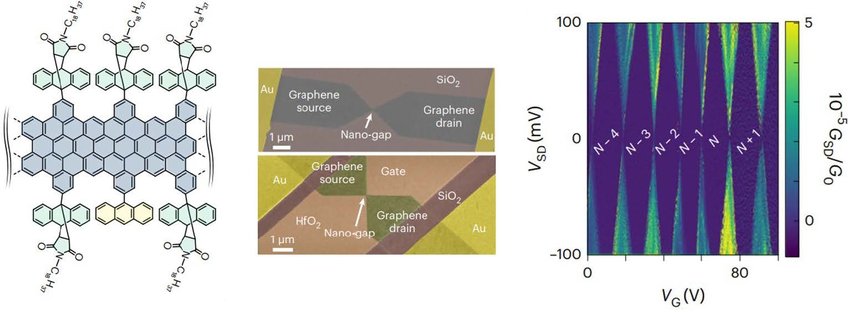Graphene nanoribbons in quantum electronics and spintronics
Exceptionally clean single-electron transistors from solutions of molecular graphene nanoribbons
Graphene has been called the wonder material, and its mechanical and electric properties never cease to amaze. The properties of graphene electronic quantum devices could be custom-tailored, if we could control the geometry of its edges at the single-atom level. Such atom-precise graphene devices would yield excellent building blocks for quantum electronics, and spintronics.
Scientists from the Max Planck Institute of Microstructure Physics, Technische Universität Dresden, University of Oxford as well as Shanghai Jiao Tong University joined forces to create atomically-perfect graphene nanoribbons in huge quantities, and integrated them into exceptionally clean electronic nanodevices. The result is a graphene field-effect transistor where it is possible to identify the coupling of electrons and single vibrational modes. The devices are remarkably simple to make, and allow skipping many of the time-consuming and expensive steps necessary for comparable carbon nanotube devices. As a consequence, such results could usher a new era for quantum electronic devices. This fruitful work of joint research has been now published in the renowned journal “Nature Materials”.
This research is a joint collaboration between scientists from Technische Universität Dresden (TUD), Max Planck Institute of Microstructure Physics (MPI Halle), Shanghai Jiao Tong University (SJTU) and Oxford University. The authors gratefully thank the European Union (ERC-CoG-773048-MMGNRs), the Royal Society (University Research Fellowship and grant), the Engineering and Physical Sciences Research Council (EP/N017188/1-QuEEN), the Norwegian State Educational Loan Fund (Keeley and Norwegian scholarships to Wadham College Oxford) and the Max-Planck-Gesellschaft (MPG) for financial support. We thank the University of Norwich for the use of their atomic force microscopy instrument and Oxford-Advanced Research Computing (ARC) for computational time.













